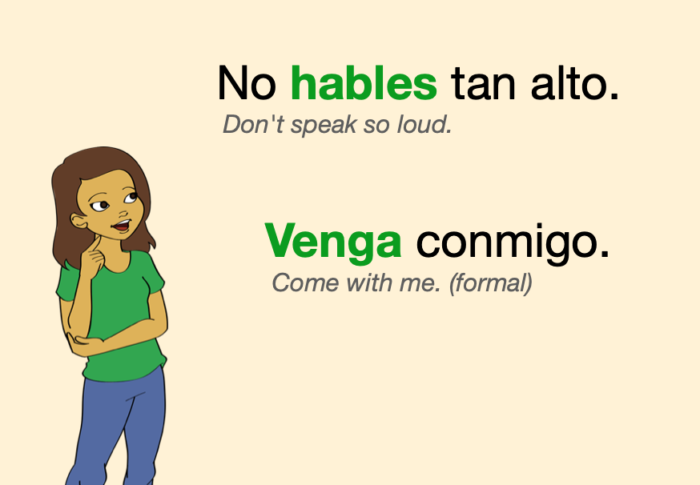Welcome 😊 to our grammar lesson on how to give negative and formal commands in Spanish.
By the end of this lesson, you will be able to give these types of commands using the correct verb forms.

You will also find a Quiz and Exercises to practice.
Important: In this lesson we are only talking about negative and formal commands.
If you want to learn affirmative informal commands, click here
Verb forms
We give negative or formal commands by borrowing verb forms from another tense: the Present Subjunctive.
Simply apply this logic:
| For a command to this person... | ... take this form of the Present Subjunctive: |
|---|---|
| tú (negative command) | tú |
| vosotros (negative command) | vosotros |
| usted (affirmative or negative) | usted |
| ustedes (affirmative or negative) | ustedes |
Let’s use the verbs “hablar” and “ir” as examples. We will first show their full conjugations in Present Subjunctive. Then we will form the different commands we are looking for.
Example 1: “hablar”
Here is the verb “hablar” in Present Subjunctive:
to speak
hablar
yo hable
tú hables
él/ella/usted hable
nosotros hablemos
vosotros habléis
ellos/ellas/ustedes hablen
And now let’s form the different commands:
Negative “tú” command → Take Present Subjunctive’s “tú” form
No hables conmigo.
Don’t talk to me.
Negative “vosotros” command → Take Present Subjunctive’s “vosotros” form
No habléis tan alto.
Don’t talk so loud. (you guys)
“usted” commands (affirmative or negative) → Take Present Subjunctive’s “usted” form
Hable con la secretaria.
Talk to the secretary. (sir)No hable con la jefa.
Don’t talk to the boss. (sir)
“ustedes” commands (affirmative or negative) → Take Present Subjunctive’s “ustedes” form
Hablen más despacio, por favor.
Please speak more slowly. (gentlemen)No hablen durante el examen.
Do not talk during the exam. (gentlemen)
Example 2: “ir”
Here is the verb “ir” in Present Subjunctive:
to go
ir
yo vaya
tú vayas
él/ella/usted vaya
nosotros vayamos
vosotros vayáis
ellos/ellas/ustedes vayan
And now let’s form the different commands:
Negative “tú” command → Take Present Subjunctive’s “tú” form
No vayas a ese bar.
Don’t go to that bar.
Negative “vosotros” command → Take Present Subjunctive’s “vosotros” form
No vayáis tan lejos.
Don’t go that far. (you guys)
“usted” commands (affirmative or negative) → Take Present Subjunctive’s “usted” form
Vaya al médico.
Go to the doctor. (sir)No vaya al curandero.
Don’t go to the quack doctor. (sir)
“ustedes” commands (affirmative or negative) → Take Present Subjunctive’s “ustedes” form
Vayan a la estación.
Go to the station. (gentlemen)No vayan a la playa hoy.
Don’t go to the beach today. (gentlemen)
Placement of reflexive and object pronouns
In order to add reflexive or object pronouns (me, te, lo, le, la, los, las, nos, os, se…) to a command, we decide their placement depending on the command being affirmative or negative:
If the command is affirmative, we attach the pronouns at the end of the verb
It can be just one pronoun or even two (one after another):
Cómprelo.
Buy it. (sir)Dúchese.
Take a shower. (sir)Díganmelo.
Tell it to me. (gentlemen)
If the command is negative, the pronouns go right before the verb, written separately
It can be just one pronoun or even two (one after another):
No me lo mandes.
Don’t send it to me.No se acueste todavía.
Don’t go to bed yet (sir).No lo tengan en cuenta.
Don’t take it into account (gentlemen).
Accent marks when we attach pronouns
Affirmative “usted” and “ustedes” commands always get a an accent mark when we attach pronouns to them.
The accent mark is always on the 3rd, 4th or 5th vowel of the resulting word (counting from right to left).
Just hear the word, and the vowel that sounds stressed must have the accent mark. Example: Cómprelo
Practice
Quiz
Take this short Quiz about formal and negative commands:
Exercise 1
A mother gives negative commands to her son Pablito. Fill the gaps using negative “tú” commands of the verbs in brackets. Click on the gray spaces to see the solutions:
1) Pablito, no hagas ruido. (hacer)
Pablito, don’t make noise.2) No comas tan deprisa. (comer)
Don’t eat so fast.3) No pongas la música tan alta. (poner)
Don’t play the music so loud.4) No te levantes tarde. (levantarse)
Don’t get up late.5) No juegues a la consola muchas horas. (jugar)
Don’t play the console too many hours.
Exercise 2
A teacher gives negative commands to several students. Fill the gaps using negative “vosotros” commands:
1) Chicos, no habléis entre vosotros. (hablar)
Guys, don’t talk to each other.
2) No miréis el móvil en clase. (mirar)
Don’t look at your cell phone in class.
3) No copiéis de vuestros compañeros. (copiar)
Do not copy from your classmates.
4) No vengáis mañana sin hacer las tareas. (venir)
Don’t come in tomorrow without doing your homework.
5) No seáis tan ruidosos. (ser)
Don’t be so noisy.
Exercise 3
A boss gives commands to an employee. Fill the gaps using “usted” commands:
1) Señor García, venga por favor a mi despacho. (venir)
Mr. Garcia, please come to my office.2) Haga usted un informe. (hacer)
Make a report.
Exercise 4
A boss gives commands to several employees. Fill the gaps using “ustedes” commands:
1) Señores, vengan por favor a mi despacho. (venir)
Gentlemen, please come to my office.2) Hablen con nuestro cliente. (hablar)
Talk to our client.








